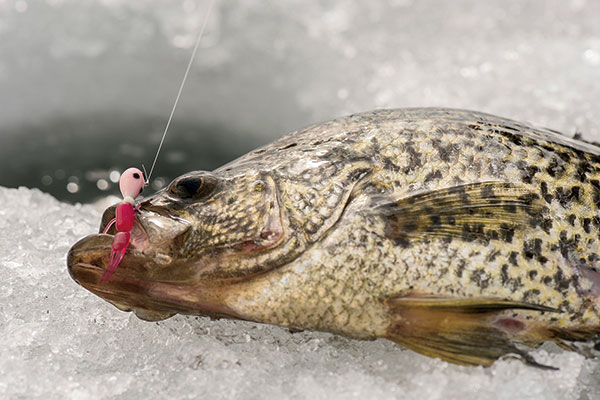
History can’t be revised, retold, or rewritten. It is what it is. And the reality is that many of the greatest ice fishing lures—particularly those for panfish—were invented by John Butwinski of Little Atom. But it’s important to understand that the evolution of modern ice lures for panfish, and the basis for many of today’s fundamental designs, goes back to the 1950s. I fear the “rest of the story” has never been adequately told.
Most panfish specialists have fished the Little Atom Nuggie, Wedgee, and Noodle— some of the first micro-sized ice plastics. What few know, however, is that Butwinski designed many classic designs—Shmoe Spoon, Rat Finkie, Atom Ant, Purist, and Rembrandt. Most of these have been mimicked once Little Atom’s original patents expired, Butwinski having passed away in 1982. Rick and Don DeBaere purchased Little Atom in 1984 and unveiled some original ice fishing plastics in 1989, including the Tease Tail, based on drawings sketched by Butwinski in the 1960s.
Little Atom designs such as the Duppie, Skimpie, and Wedgee caught fire in the 1990s, quickly becoming go-to lures in early ice competitions. Rick DaBaere released the Nuggie in 2004, which Phil Morse tipped on a Fiskas jig to win the North American Ice Fishing Circuit (NAIFC) Championship. The Fiskas/Nuggie pairing became a tournament phenom, accounting for at least six NAIFC Championships. In terms of prominent, productive, important ice plastics, I rank it number one of all time.
Little Atom Rat Finkie: Almost every veteran ice angler has fished this masterpiece jig, yet few know the Rat Finkie was invented in 1964 by Butwinski, founder of Little Atom Lure Company. The original Finkie launched the trend toward horizontal-hanging ice jigs, the focus of countless designs to come. The objective remains to present the jig in a nearly parallel posture, positioning the hook at the optimal hook-set angle.

The Rat Finkie has been a confidence jig for me, triggering bites day after day, season after season. Other Finkie assets: Fine-wire hook, soft tubular body, and the fact you can tip it with a single larva or softbait to create the illusion of a tiny bite of food, natural in appearance and texture.
Five rows in my 30-year old Scientific Anglers box are crammed with Finkies, most solid white-glow, glow-pink, or solid purple. The white glow pattern with a single waxworm or half a Little Atom Wedgee has probably put more sunfish on the ice for me than any other three lures combined. The #12 and #14 sizes are tops for finessing big bluegills, while larger ones are awesome crappie jigs, tipped with a tiny minnow, jumbo waxie, or color-matched Wedgee or Ice Mite plastic.
Lindy Ice Worm: An extension of the horizontal jig concept, the tri-segmented Lindy Ice Worm (previously called the Genz Worm), was created by the master himself. Dave Genz intended it as a lure to reach deep perch faster, though it works in many situations. Two key features give it a rapid, nearly horizontal drop: An oversized head segment and an eyelet positioned further down the hook shank. Snug the knot tight to create a 90-degree angle between line and hook shank. Then tip it with a mass of eurolarvae to get the Ice Worm rocking as you jig it. A Berkley PowerBait Ice Whipworm also creates a segmented worm effect, an awesome big perch combo.
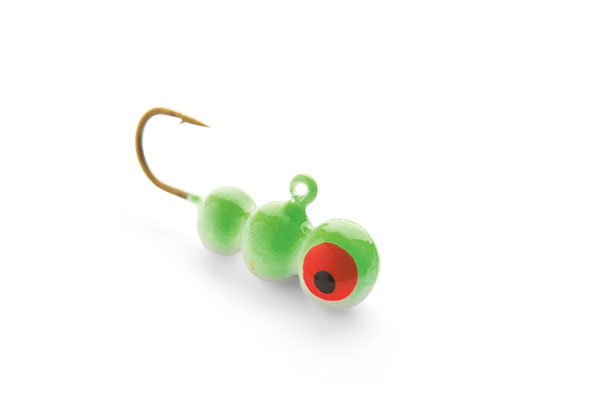
Fished over soft-bottom zones, this combo is killer for fish feeding on bloodworms. Genz advocated a slow, vertical climb, emulating the ascending actions of midge larvae as they vacate their benthic habitat. Drop the jig to the bottom and slowly inch it upward, using little rod tip quivers to make the jig dance as it rises, before dropping it back into the substrate.
Of note for this season is the introduction of a tungsten Lindy Ice Worm, along with tungsten renditions of their Toad, Bug, and Fat Boy.
Little Atom Shmoe: Created by Butwinski in 1959, the Shmoe Spoon remains deadly for most veteran crappie anglers, though often under other names. The Shmoe’s magic stems from its two-tone colorations—glow head, contrasting body—as well as its light-wire hook. Tip it with a small minnow, with the hook lightly piercing the skin parallel to the dorsal fin, point toward the head.
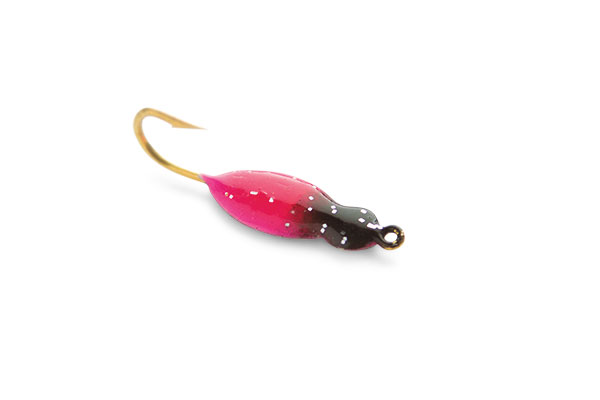
This combo has been so effective for crappies, perch, and walleyes that it could appear beside the definition of deadstick. The original thin gold hook remains an indispensable detail, pairing beautifully with tiny minnows. It’s light enough to keep baits alive and kicking, and can be bent repeatedly without breaking. I open the hook gap slightly, so it’s barely offset, and it hooks and holds crappies and walleyes better.
The Shmoe’s so productive fished in place with a lively minnow that it’s not necessary to jig it. But when you see fish eyeballing it on sonar or a camera, a fluid sweep of the rod, followed by a slow fluttering pause, usually closes the deal.
Fiskas Wolfram Epoxy Jig: Unlike the bass segment of the sport in which casual anglers follow tournament results like box scores, most ice fishers pay little attention to competitive events. That’s unfortunate when you consider some of the biggest breakthroughs—such as tungsten jigs and plastics—first gained fame in circuits such as the ‘Trap Attacks and NAIFC.
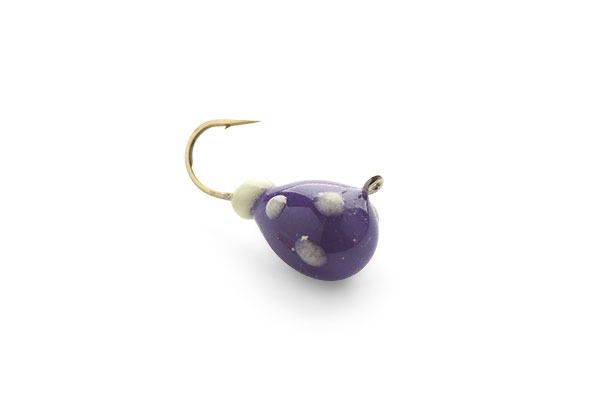
Anglers such as Mike McNett, Tony Boshold, and Phil and Jeff Morse have won so many NAIFC events with Fiskas Wolfram (tungsten) jigs that it’s surprising the tungsten trend took so long to go mainstream. Jamie Olson, owner of yourbobbersdown.com—primary North American distributor of Sweden-based Fiskas jigs—says more tournament money has been won with a 4-mm Fiskas E Series jig, white with glow red bead, than any other single ice lure. He ought to know, having sold thousands of them to tournament anglers out of his van during in the early tourney days.
A Fiskas Wolfram jig, coupled with a Little Atom Wedgee or Nuggie, is the archetypal tungsten-plastic pairing and Fiskas remains my all-time favorite. Hooks are fine-wire, durable, and sticky sharp. The paint doesn’t chip and their red and purple jigs with glow beads on the hook shank remain favorites. You can tie them with a loop knot to add jig action and pivot, but I’ve become a fan of the snell knot tied around the base of the head, which serves like a barb for holding softbaits in place.

Fiskas N24 Balance: It’s amazing that anglers continue to overlook this incredible bluegill jig, especially considering it’s in the same category as the classic Rapala Jigging Rap. Fiskas offers 29 varieties of “balance” lures, and the N24 “Gill Getter” is maybe the most remarkable. With a single hook on either side of the jig’s head, sunfish and other reluctant biters can’t bite it without getting stung.
Past NAIFC champion Phil Morse is a balance lure fanatic, tipping one hook on the Gill Getter with a Micro Nuggie. “No matter how or where ‘gills bite this jig, they can’t avoid one of the tiny hooks,” he says. “It glides beautifully after you twitch it and returns to a perfect horizontal posture at rest.” It’s tiny, just 1/50-ounce with two #18 hooks. But amid tough bites, it’s hard to beat.

Akara Disco Ball: We’ve often written in In-Fisherman about the value of through-head style tungsten jigs for fishing thread-thin lines for small fish. If you ask top ice anglers from Latvia, Russia, and North America to agree on one elite ice jig, it would almost certainly resemble a gold Akara Tungsten Mormishka Disco Ball.
Through-head jigs require the angler to tie a snell knot, passing the line through the jig’s head, and wrapping it around the hook shank. The advantage is a knot that doesn’t require repositioning or retying nearly as frequently as other designs, and a jig that hangs at the same near-horizontal posture. The knot also serves as a barb or keeper to secure softbaits.
What separates gold disco ball heads from plain or painted heads is the reflective properties of the multi-faceted metallic surface. When you look at this jig on an Aqua-Vu camera, you can’t miss the sparkle its faceted surface creates. Gold can be an exceptional hue for bluegills and crappies. I spent most of the 2015 season fishing this jig for sunfish and never regretted it. And it’s a confidence jig for some of the best panfish anglers I know.
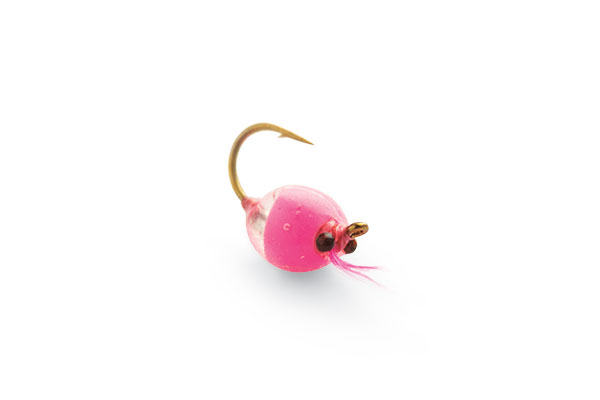
Jeff’s Jigs Tungsten Zoo Bug: A departure from about every other jig you’ve fished, the Zoo Bug is an exceptional Daphnia mimic, the only one I know of. In 2013, master fly and jig tier Jeff Wenger and I began discussing the possibility of producing a super-realistic zooplankton imitation. Wenger blew me away with the Zoo Bug, a beautiful transparent-bodied jig-fly with anatomically correct antennae and an internal tungsten bead. Unique to the Zoo Bug is its semisoft epoxy exterior, weighted body, and remarkable underwater action, mimicking the real thing in a supersized rendition.
It’s garnered a considerable following, particularly among younger tournament anglers and guides, prompting Wenger to quit his “real job” and become a full-time tier. He sells loads of these jigs, staying busy year-round.
Give it short darting actions with a Thorne Bros Quiverstick Stealth or other fast-tip ice rod, imitating the bug-like stop-and-go motions of live Daphnia—one of the primary wintertime foods of crappies and sunfish. Tip it with a single waxworm, a trio of eurolarvae, or a plastic tail, such as a J & S Plastics Ice Mite Jr., or fish it plain.
With the success the Zoo Bug, Wenger also offers Tungsten Copepods, Scuds, and a sweet shrimp imitation. Don’t go to Devils Lake without a stash of his Tungsten Shrimp, a favorite producer of big crustacean-munching perch.
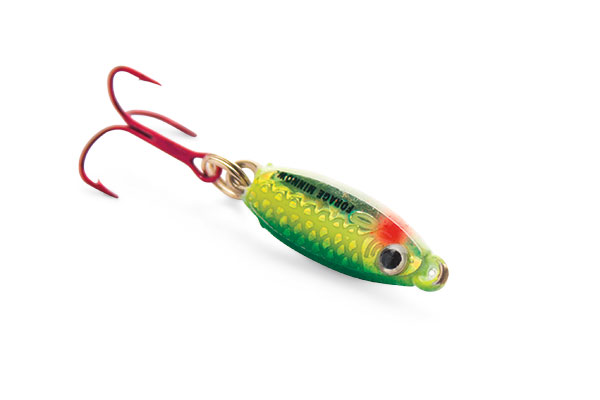
Northland Tackle Forage Minnow Spoon: Probably the lure responsible for more big perch than any other in my box, a 1/32- or 1/16-ounce Forage Minnow Spoon is an amazing lure. With a bent shape in a small package, its thin silhouette is suggestive of food.
Given the spoon’s lifelike qualities, you can’t fish it wrong by imparting tiny twitches or raising it by slowly elevating your rod tip or reeling. Try to get perch and crappies to chase the lure up in the water column until they can’t resist striking. That failing, quickly flutter the spoon back to bottom and start over again.
Tip each tine of the red treble hook with multiple maggots or a small minnow head. I’ve also had success with a Northland Impulse Perch Eye. Choose a tipping that’s heavy enough to make the hook pivot and dance with the slightest movement of the lure.
Salmo Chubby Darter: The original “ice crankbait,” the Salmo Chubby Darter is another one with a cool story, created by In-Fisherman digital editor Jeff Simpson. He carved prototypes for what would become the Salmo Chubby Darter over 15 years ago. “I grew up fishing South Dakota’s prairie lakes, which lack structure or edges,” Simpson says. “The fish there are nomads; you have to move and drill constantly to stay on the bite. The idea behind the Chubby Darter was to create a lure that would call fish to me.
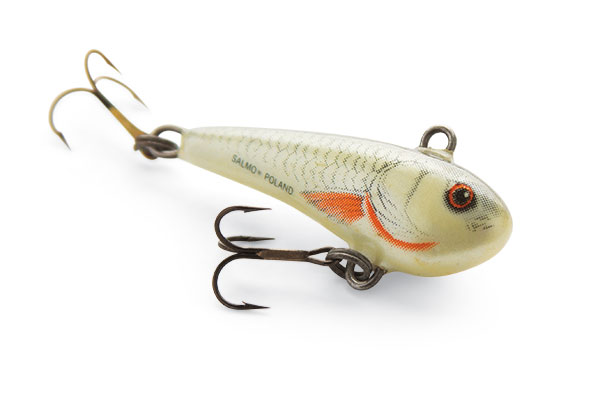
“I carved the first ones from balsa, then weighted them with enough lead to sink. That first day, my friend Paul Schamber laid on the ice and watched the action. Within seconds of jigging the first Chubby Darter, walleyes and perch were surrounding and striking it. Everywhere we drilled a hole and dropped the bait, fish seemed to swarm it. Salmo in Poland didn’t stray from my original prototypes, other than to add sweet paint jobs and build the lures from foam instead of wood.
Simpson says the Darter was the first of its kind, with an action similar to a crankbait, vibrating and darting on the upstroke, wobbling on the fall. It’s may be the best ice lure for triggering jumbo crappies, perch, and walleyes I’ve fished, depending on what size you select among 4 options from 11â’„3- to 21â’„2 inches.
Rapala Jigging Rap: The W2 and W3 Jigging Rap is, like several others on this list, a timeless, hall of famer that always catches fish. Over deep flats or along drop-offs, the Rap remains an efficient, alluring option, particularly for big perch and crappies. For years, we talked about tipping the treble hook with maggots or a minnow head. Today, we know this is generally unnecessary. Keep it twitching and dancing as you jig it in the water column, daring fish to chase and commit. Pause frequently.
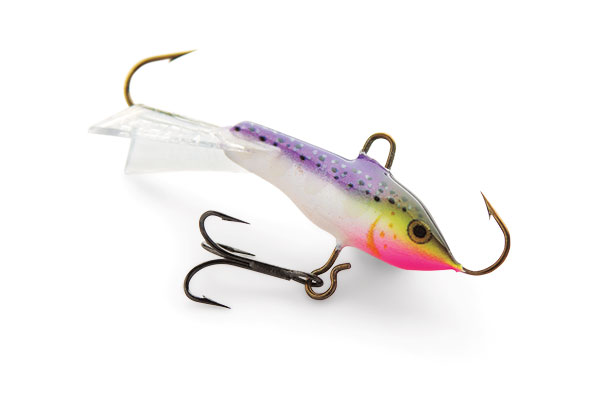
Fished with one of the micro braided lines (I like 3-pound test Sufix Nanobraid) and an 18-inch leader of 4-pound fluorocarbon, a W2 Jigging Rap also is an overlooked bluegill bait, selecting for big fish. One overlooked presentation involves holding the Rap still, just above fish level, and occasionally quivering it nervously.
*In-Fisherman Field Editor Cory Schmidt, Brainerd, Minnesota, is an avid ice angler and industry insider.










































